Global Warming: An Introduction to the Research and the Nature of Science
Since November, 2006, I have been enjoying a series in Natural History Magazine entitled “Samplings: The Warming Earth”. (scroll down the page to find the “Samplings” specific to “The Warming Earth.”) The articles are actually very concise summaries of research published in professional journals. The samplings are representative of a wide range of research. For example, there are summaries of research that predict possible effects of climate change (as “Pipefish Baby Boom”) to identification of contributing factors (“Don’t Blame the Sun”), to how climate change may be tracked (“Reading the Leaves”). Here’s a sample from one of this month’s (May 2007) “Samplings:”
Oysters on the half shell are considered a delicacy, but what about mussels on the three-quarter shell? A new study shows that human emissions of carbon dioxide (CO2) could reduce bivalves’ ability to build their shells by as much as 25 percent.
In addition to warming the Earth, excessive CO2 is making the oceans more acidic, which decreases the concentration of dissolved carbonate in seawater. Without carbonate for building their shells, numerous minute organisms—including corals and species of phytoplankton and zooplankton—are showing alarming signs of distress. Now Frédéric Gazeau, a marine biologist at the Netherlands Institute of Ecology in Yerseke, and several colleagues have shown that the phenomenon propagates up the food chain.
In the laboratory, Gazeau exposed mussels and oysters to water with various levels of CO2 for periods of two hours, measuring the water’s average pH and the change in its alkalinity, which is proportional to its concentration of carbonate. From alkalinity levels he calculated the mollusks’ rate of shell construction, or calcification. Sure enough, the higher the water’s CO2 concentration and the lower its pH, the slower the mollusks’ calcification.
If atmospheric CO2 reaches the levels expected by 2100, Gazeau predicts the calcification of oyster shells could decline by 10 percent and that of mussel shells by a quarter. As the declines in calcification affect the development of juvenile shellfish, and as adults become more vulnerable to predation, both aquaculture and marine ecosystems are likely to change. Gazeau stresses that his findings are preliminary; he measured only short-term responses to high CO2 and low pH. But his next experiment will test their responses over several months. (Gazeau, F., C. Quiblier, J. M. Jansen, J. Gattuso, J. J. Middelburg, and C. H. R. Heip [2007], “Impact of elevated CO2 on shellfish calcification,” Geophysical Research Letters 34, L07603, doi:10.1029/2006GL028554)Links: Netherlands Institute of Ecology (NIOO)
Laboratoire d’Océographie de Villefranche (LOV)—Rebecca Kessler
Recently in class a student commented that he didn’t “believe” in global warming. When asked why, he responded that he didn’t see how scientists could study such a phenomenon. This student comment followed upon the heels of a conversation with a colleague in which we lamented the difficulty of providing students with insights into the nature of science. It occurred to me that perhaps the Natural History “Samplings” might be a way in which I could simultaneously introduce my students to some of the research on global warming and provide insights into “how scientists know what they know”.
This turned out to be a very simple, but effective assignment. My students were asked to read a specific number of summaries (depending on the grade they wanted to earn). For each article they selected to read they needed to identify three components: the research question or problem; the kind of data collected and/or an explanation of how the data was collected (through field experiment, computer modeling, etc); and the conclusion of the research. After reading as many summaries as they committed themselves to, they were asked to write a reflective summary in which they explained what they learned about global warming or about how scientists work.
Based on what my students wrote (9th grade biology) and on a follow-up class discussion, I found this simple assignment to be successful. In addition, it had the benefit of piquing their interest in global warming!
Sandy Collins
Biology (9th grade)
West Junior High School
Lawrence, KS 66044
scollins@usd497.org
